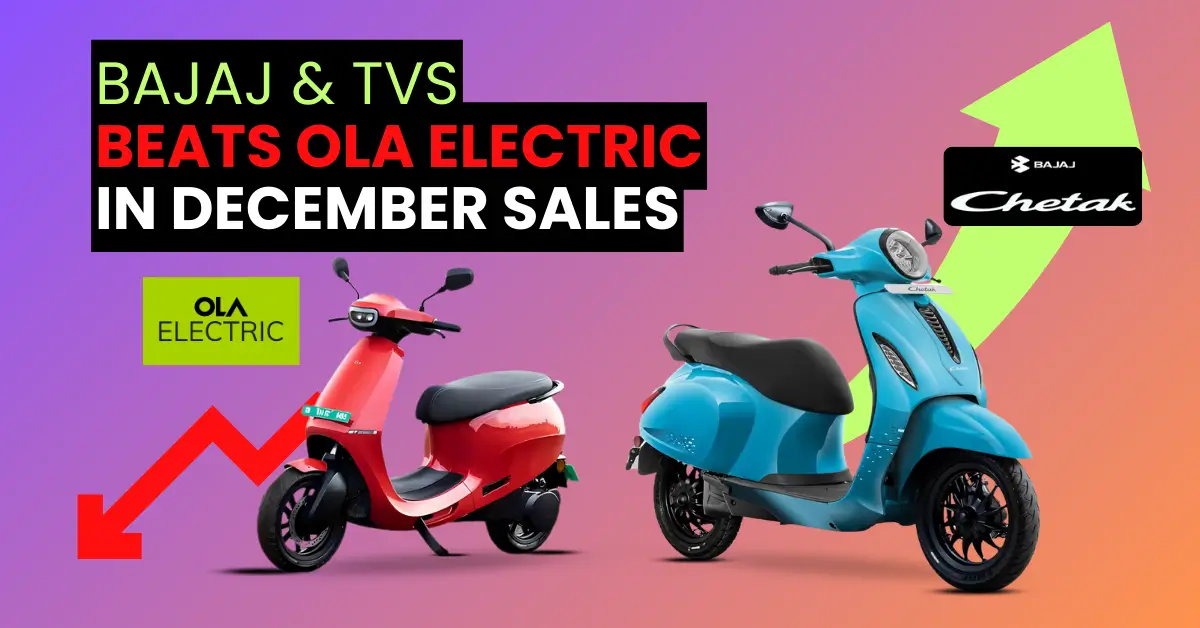
The year 2024 brings significant changes to the Indian electric two-wheeler market. Ola Electric initially took the top spot with an impressive market share of over 60 percent by 2024. And Ola Electric has become the only company to sell over 4 lakh electric scooters in India till date.
However, frequent customer service complaints and product quality issues have thrown up challenges for the EV startup, creating opportunities for competitors to gain ground.
The dominance of legacy brands like Bajaj Chetak and TVS Motors has made a big change. There has been a very positive development in the market share and sales of Bajaj Chetak in December 2024.
Current sales records show that Ola Electric is losing its crown as the top leader in the electric two-wheeler industry to legacy brands like TVS Motors and Bajaj.
Bajaj sold 17,431 electric scooters in December, at the 2nd spot TVs Motors sold 16,301 electric scooters, and in the 3rd spot, Ola Electric sold 13,106 electric scooters. and with this Bajaj Chetak Became Best Selling Electric Scooter in India in December 2024.
| Brand | Units Sold as of 30 Dec 2024 |
|---|---|
| Bajaj | 17,431 |
| TVS Motors | 16,301 |
| Ola Electric | 13,106 |
Source: Vahan Dashboard
As Ola struggled with unresolved concerns, brands like TVS and Bajaj took advantage of the situation and worked on their sales, market share, success plans, etc.
This shift saw Ola Electric’s market share decline significantly, dropping to just 24 percent. Meanwhile, TVS gained a 23 percent share, and Bajaj closely followed with 22 percent.
According to Vahaan sales data, Bajaj sold 17,431 units, while TVS iQube recorded sales of 16,301 units, placing Ola in third place with 13,106 units as of December 14. and with this Bajaj Chetak Became Best Selling Electric Scooter in India in December 2024.
Building on its sales growth, Bajaj Auto achieved a significant milestone by attaining a 37 percent market share in December, making it the new leader in the electric two-wheeler segment. TVS followed with a 34 percent share, and Ola’s position dropped further to 28 percent.
This growth is particularly remarkable for Bajaj, as the Chetak electric scooter, launched in 2020, is on track to become India’s best-selling electric scooter for the first time.
The timing is crucial, with the new version of the Bajaj Chetak introduced on December 20.
The next-gen Bajaj Chetak will feature a new chassis for improved practicality while keeping its classic retro design, including a round LED headlight and curvy body panels.
The Scooters have slight tweaks like reshaped taillamps but note the absence of features like a lockable glovebox and keyless start/stop.
The updated Chetak might include a repositioned battery, potentially increasing its range beyond the current 123 km and 137 km options.
With simplified features like a basic LCD, it is more affordable than the current ₹1.29 lakh price range.
The competitive environment in the electric two-wheeler space has never been more intense. Bajaj’s growing sales numbers demonstrate its ability to challenge Ola’s earlier dominance, while TVS is steadily strengthening its presence.
The market dynamics reflect how quickly consumer preferences can shift when new players and improved products enter the scene.
Given these developments, Ola Electric may respond with strategic measures such as year-end discounts to address its declining sales figures, as the company has done in the past. Whether Ola can regain the lost market share or maintain its position against the growing competition remains to be seen.
We believe a strong marketing strategy and addressing quality concerns will be key to the company’s recovery.
The Indian EV market in 2024 has witnessed a remarkable shift in dynamics. Legacy brands like Bajaj and TVS have successfully capitalized on customer trust and reliability, pushing ahead in sales while Ola Electric has struggled with service issues and quality concerns.
Bajaj Chetak’s rise to the top, even before the launch of its updated version, shows how traditional players are adapting to the EV revolution. Meanwhile, TVS has steadily grown, proving that consistent performance can compete with disruptive newcomers.
In the coming months, the market will likely get even more competitive with the anticipated launch of the Honda Activa Electric in 2025. Ola Electric still has a chance to bounce back if it prioritizes customer satisfaction and product quality.
For consumers, this fierce competition is a win, bringing better options and advancements. It’s an exciting time for EV enthusiasts, as every brand aims to shape the future of sustainable mobility in India.
This post was last modified on December 30, 2024 11:04 am
In a major stride toward sustainable mobility, the Himachal Pradesh Police have incorporated six custom-modified Tata Curvv electric vehicles into…
In India, the automotive and transport industry is undergoing significant changes. This transformation isn't just about improving roads and infrastructure;…
Montra Electric, the clean mobility brand from the prestigious Murugappa Group, has launched the All-New Super Auto, a next-generation electric…
Union Minister Nitin Gadkari (Minister of Road Transport and Highways of India) has once again made a bold statement that’s got…
India’s electric four-wheeler (E4W) market slowed in September 2025, following a record-breaking August, with 15,038 units sold, representing an 18%…
India’s EV market hit 1,04,056 electric two-wheeler sales in September 2025. TVS, Bajaj, and Ather led the chart, while Ola…
This website uses cookies.